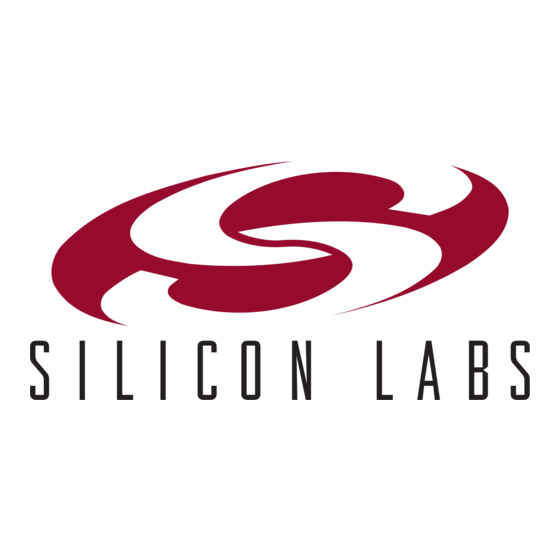Table of Contents
Advertisement
Quick Links
Download this manual
See also:
User Manual
SiM3L1
B
XX
1. Introduction
The Badger Board is controlled by Silicon Labs' SiM3L1xx, an ultra low-power Cortex-M3 microcontroller. The
entire board is powered solely by a small supercapacitor and demonstrates best-in-class low-power operation. The
board can remain running with the LCD enabled for days from as little as a 90-second charge and, under typical
use, can last up to a week from a three to five minute charge. Figure 1 shows the SiM3L1xx Badger Board.
The SiM3L1xx MCU has the following key power specs:
175 µA/MHz active mode operation
950 nA supply current with LCD and contrast control enabled
Segment resetting achieves 40 percent reduction in LCD load current
300 nA supply current with RTC in Crystal Mode
180 nA supply current with RTC in LFO Mode
75 nA supply current in Power Mode 8
The Silicon Labs Precision32™ SiM3L1xx 32-bit MCUs are ideal candidates for ultra low-power system designs. In
addition to providing an evaluation platform for ultra low-power LCD-based designs, the SiM3L1xx Badger Board
serves as a lower-cost, general-purpose development platform for the SiM3L1xx MCUs.
2. Relevant Documents
This document provides a hardware and software overview for the SiM3L1xx Badger Board. Additional
documentation on the Precision32 tools and MCUs can be found on the following Silicon Labs web sites:
www.silabs.com/32bit-appnotes
www.silabs.com/32bit-software
www.silabs.com/32bit-mcu
Rev. 0.2 2/13
B
A D GER
OARD
Figure 1. SiM3L1xx Badger Board
Copyright © 2013 by Silicon Laboratories
U
'
G
SER
S
UIDE
AN757
AN757
Advertisement
Table of Contents

Subscribe to Our Youtube Channel
Summary of Contents for Silicon Laboratories SiM3L1XX
- Page 1 LCD enabled for days from as little as a 90-second charge and, under typical use, can last up to a week from a three to five minute charge. Figure 1 shows the SiM3L1xx Badger Board.
-
Page 2: Hardware Setup
AN757 3. Hardware Setup Connect the badger board to a USB port on the PC using the USB extender cable shown in Figure 2. Once the board is plugged in, the blue LED (DS9) will turn on indicating that the badger board is ready for use. Figure 2. -
Page 3: Charging The Badger Board
There is no risk of overcharging the supercapacitor if the board is connected to USB indefinitely. 6. Demonstration Mode The demonstration mode cycles though the key power specs for the SiM3L1xx MCU. Press the push button switch (S1) to advance to the next specification. After all the specifications have been displayed, the elapsed time (since the charger was last disconnected) and the current voltage on the super capacitor are displayed on the LCD. -
Page 4: Programming Mode
AN757 8. Programming Mode The user-defined string can be programmed through the light sensor. Hold the push button switch (S1) down until four arrows appear and then disappear from the screen (approximately six seconds). Upon releasing the switch, the LCD will display “Sensing” and begin a 10-second countdown. A “light-to-dark” transition on the light sensor will initiate the data transfer over the light sensor. -
Page 5: Turning Off The Badger Board
AN757 Occasionally, ambient light conditions will not be ideal for updating the user-defined string over the light sensor interface. It is important that the iOS device be located in close proximity to the badger board to block out ambient light when it is transmitting a “dark” pulse. It is equally important to ensure that the iOS screen brightness is set high enough to generate sufficient light when transmitting a “light”... -
Page 6: Badger Board Hardware Overview
10. Badger Board Hardware Overview The badger board enables low-power application development on the SiM3L166 MCU and easy prototyping for other SiM3L1xx MCUs. Figure 7 shows the badger board features. Full schematics for the board can be found in 12. "Schematics" on page 9. - Page 7 AN757 10.1. Push-Button Switches and LEDs (S1, DS5, DS9, DS10) The badger board has a push-button switch and two LEDs summarized in Table 1. The switches connect to PB0.3 (S1). The switch is normally open and pulls the pin voltage to ground when pressed. Port pin PB2.6 connects to the red LED (DS8), and PB2.7 connects to the green LED (DS10).
-
Page 8: Badger Board Firmware Overview
AN757 11. Badger Board Firmware Overview 11.1. System Overview The badger board firmware uses an event-driven architecture to stay in Power Mode 8 (PM8) at all times except when necessary to perform a system task. The two hardware wakeup sources used are pin wake and RTC wake. In active mode, the MCU operates on its 20 MHz low-power oscillator, and the APB clock is set to AHB/2. - Page 9 AN757 12. Schematics Rev. 0.2...
- Page 10 AN757 Rev. 0.2...
- Page 11 AN757 Rev. 0.2...
-
Page 12: Bill Of Materials
AN757 13. Bill of Materials Table 2. Badger Board Bill of Materials Reference Part Number Source Description C24, C39 C0603X7R100-105K Venkel 1 µF Capacitor C25, C28, C0603X7R100-104K Venkel 0.1 µF Capacitor C36, C40 EEC-S5R5H105 Panasonic 1F Super Capacitor C0603X5R6R3-106M Venkel 10 µF Capacitor C35, C41, C0603X7R100-225K... - Page 13 AN757 Table 2. Badger Board Bill of Materials (Continued) Reference Part Number Source Description EVQ-PAD04M Panasonic Corp. Momentary SF1, SF2, SJ61A6 Bumper SF3, SF4 CF326-SX0261GM SiLabs CF326-SX0261GM SiM3L166-C-GM SiLabs SiM3L166-C-GM GS-12811BA-1-1 Glory Sound Asia LCD 14x8 Current Measure Icons U6, U7, U8, DMN5L06VK Diodes Inc.
- Page 14 Silicon Laboratories products are not designed, intended, or authorized for use in applications intend- ed to support or sustain life, or for any other application in which the failure of the Silicon Laboratories product could create a situation where personal injury or death may occur.


Need help?
Do you have a question about the SiM3L1XX and is the answer not in the manual?
Questions and answers